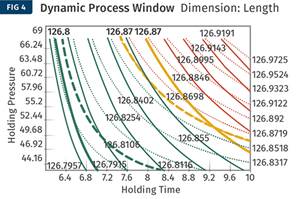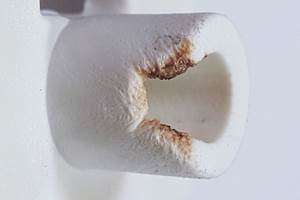How to Design Three-Plate Molds: Part 5
There are many things to consider, and paying attention to the details can help avoid machine downtime and higher maintenance costs. In this installment, the focus is on design and placement of sucker/puller pins.
In Part 4 of this series, I discussed several aspects of sucker pins, or puller pins in three plate molds, such as their installation method, tip shape, undercut and more. Now let’s talk about how they should be designed and where they should be placed.
Figure 1A depicts one of the most common locations for a sucker pin in a three-plate mold — directly over the runner drop. Figure 1B is a slightly better design because it has a short runner overflow to help capture and retain any unwanted material, such as a cold slug. Figure 1C is a much better design because it has a longer runner overflow, and the sucker pin is situated beyond the runner drop. This location does not impede the material flow in any way.
That’s particularly important for highly viscous materials and materials that have high percentages of fillers, such as glass or minerals. Abrasive materials have also been known to eat away at sucker pins, which does two things: reduces the holding power of the pin; and leaves small metallic particles on the molded parts. Additionally, the sucker pin in this design will be cooler than if it was directly above the runner drop because the material flow only contacts the pin initially and is not subjected to any shear heat as the material continues to flow into the cavity.
Figure 2 shows alternate designs for sucker pins that do not impede the flow of material. Multiple sucker pins are an excellent means of pulling out large runner drops or drops with large gates that are difficult to break.
If an offset sucker pin design is having issues pulling out the runner drop and extending the cycle time, consider adding structural gussets, like those shown in Figure 3, connecting the runner to the well.

FIG 3 Gussets connecting a runner to a runner drop. Source: J. Fattori
If you have a sucker pin directly over the runner drop, you need to ensure there is sufficient material flow around the pin and into the bore hole of the drop. This is accomplished by adding a well around the sucker pin in the back of the A-plate. If the well is too small or nonexistent, as shown in Figure 4A, there can be a large pressure drop — which can cause short shots and other molding issues.
Conversely, if the well is too large, as shown in Figure 4B, it wastes material and often requires an increased cycle time for the well to solidify sufficiently for the sucker pin to pull the drop out.
So how big should a well be? Simply put: the well should be large enough where it does not restrict the flow of material. At a minimum, the flow area around the two sides of a pin should be equal to the cross-sectional area of the pin itself. Figure 5 specifies some general guidelines for sizing sucker pin wells.
Runner Drops
The first thing to consider about runner drops is their length and diameter. The longer and larger they are, the harder it will be to remove because there is more surface area trying to prevent their extraction. It’s worth asking yourself if the A-plate can safely be a little thinner. A thinner A-plate will reduce the length of the runner drops and the amount of surface area. It will also reduce the weight of the A-plate, which is an added benefit.
The next thing to consider is the included angle of the drops. That can be anywhere between 1 and 4 degrees included, with 2 degrees included being the most common.

FIG 5 Sucker and well-sizing guidelines. Source: J. Fattori
For most materials, the surface finish should be smooth — somewhere between a Plastics Industry Association B3 to A3 rating. However, some materials such as polyethylene and polypropylene tend to stick to a polished surface, and a D1 finish is usually preferable. A D1 finish is a 600-grit stone followed by a dry blast glass bead #11.
Regardless of the surface finish, it is extremely important that the stoning or polishing be done in the line of draw, even with a D1 finish. It’s not critical to have small score lines parallel with the drop. But microscopic annular rings caused by rotary polishing act as undercuts, which can prevent the drops from being pulled out of their bore holes.
Anytime a runner drop passes through one plate into another or to a mold insert such as a cavity, a step must be added to prevent an undercut from forming due to even the slightest misalignment of the plates. Figure 6 shows a runner drop with two transitional steps. The steps are typically 0.002 inch to 0.010 inch per side.

FIG 6 A runner drop with two transitional steps. Source: J. Fattori
Machining Cooling Channels
The mold’s runner stripper plate and the A-plate should have cooling channels machined in them. The cooling channels help speed up the solidification of the runner, as well as help keep the sucker pins cool. If the pins get too hot, the cycle time may need to be increased so the material sufficiently solidifies around the pin, enabling it to pull the runner and runner drops out of the back of the A-plate.
This is one reason why the tapered sucker pin, which was discussed in Part 4 of this series, is a very good design. It has more direct contact with a cooled plate. If the sucker pin is controlling the cycle time because it is too hot, you might consider using sucker pins made of a copper alloy. They will wear faster because they are softer, but they cool off faster. To reduce the wear rate, copper alloys can be plated or coated with several different types of materials, such as Diamond Like Carbon (DLC), which has a surface hardness of over 90 Rc.
Because the runner is usually the thickest portion of the molding, the cooling of the runner is critical in minimizing the cycle time. The ratio of cooling time to wall thickness is nonlinear. For example, let’s say the wall thickness of the part was 0.100 inch,and the wall thickness of the runner was twice that, or 0.200 inch.
Even though it is twice as thick, it can take three, four or even five times longer to solidify, because once the outer skin solidifies, it insulates the molten center. This is where structural ribs, as discussed in Part 2 of this series, can help prevent ejection problems. The runner usually doesn’t need to completely solidify. It just needs to be rigid enough for the sucker pins to pull out the drops.
Cooling lines should be located at the thickest sections, which would be the primary runner, runner intersections and especially the intersection of the runner and the drops. This is why you should have cooling lines in both the runner stripper plate and the A-plate located in close proximity to those areas.
Another cooling concern is when you have multiple runner drops in close proximity to each other, such as when gating into a small to medium-sized gear, as shown in Figure 7. In this situation, you might consider machining the runner drops in a cylindrical insert, with water flowing around it.

FIG 7 Multiple runner drops. Source: J. Fattori
It’s also not a bad idea to put some cooling lines in the injection clamp plate. The molding machine’s heated nozzle tip is always in contact with the extended sprue bushing. Over time, the heat will transfer to the clamp plate through both conduction and radiation. This could cause a thermal expansion issue which, in turn, could prematurely wear the sucker pin bore holes.
About the Author: Jim Fattori is a third-generation injection molder with more than 45 years of molding experience. He is the founder of Injection Mold Consulting LLC. Contact jim@injectionmoldconsulting.com; injectionmoldconsulting.com.
Related Content
Optimizing Pack & Hold Times for Hot-Runner & Valve-Gated Molds
Using scientific procedures will help you put an end to all that time-consuming trial and error. Part 1 of 2.
Read MoreBack to Basics on Mold Venting (Part 1)
Here’s what you need to know to improve the quality of your parts and to protect your molds.
Read MoreHow to Select the Right Tool Steel for Mold Cavities
With cavity steel or alloy selection there are many variables that can dictate the best option.
Read MoreImprove The Cooling Performance Of Your Molds
Need to figure out your mold-cooling energy requirements for the various polymers you run? What about sizing cooling circuits so they provide adequate cooling capacity? Learn the tricks of the trade here.
Read MoreRead Next
For PLASTICS' CEO Seaholm, NPE to Shine Light on Sustainability Successes
With advocacy, communication and sustainability as three main pillars, Seaholm leads a trade association to NPE that ‘is more active today than we have ever been.’
Read MorePeople 4.0 – How to Get Buy-In from Your Staff for Industry 4.0 Systems
Implementing a production monitoring system as the foundation of a ‘smart factory’ is about integrating people with new technology as much as it is about integrating machines and computers. Here are tips from a company that has gone through the process.
Read More








 (2).jpg;maxWidth=300;quality=90)



















